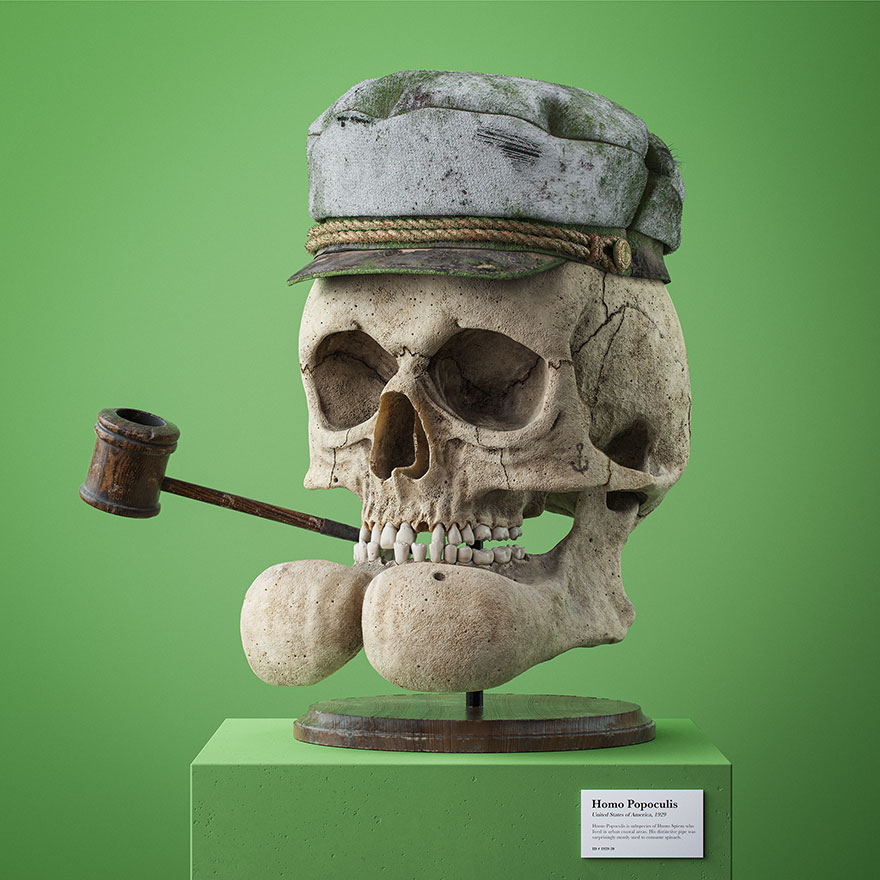
Anatomically Correct Skulls Of Popular Cartoon Characters By Czech Artist Filip Hodas
Remember your last trip to the History Museum? Let me take this one for you—the answer is “nay” ’cause you were half asleep, dreaming of a juicy burger, and thinking of ways to sneak out through the staff back door so you wouldn’t have to explain yourself in a family intervention once you set foot inside the car. Imagine how different the whole experience would have been if the specimens had been some of the famous characters from animated movies.
The 3D artist Filip Hodas has made this unlikely scenario possible in his new Cartoon Fossils digital art that features anatomically correct skulls of cartoon icons from grumpy Uncle Scrooge to cheerful Sponge Bob. Plus, every “specimen” features hilarious zoological names like “Canis Goofus” and the year they first aired on TV.
It’s not the first time the Prague-based designer has surprised Pandas with his mind-bending renderings. Previously, he creeped everyone out with character design illustrations of a dystopian future where burnt-out Pac Man and defunct Hello Kitty look nothing like their previous selves.
Let’s take a walk through this virtual exhibition hall, and don’t forget to keep your flashlight off. Scroll down below for Bored Panda’s interview with the artist himself about inspiration and the process of making the surreal skeleton drawings.
More info: Instagram | Behance | Facebook
Canis Goofus – USA, 1932
Image credits: hoodass
Image credits: hoodass
Anas Scroogius – USA, 1947
Image credits: hoodass
Image credits: hoodass
Bored Panda asked Filip Hodas how he came up with such a unique idea for his project and he confessed that “after I finished the 12-image series Pop Culture Dystopia, I was quite burned out and wanted something different.” Then Filip produced a series of colorful animal skull anatomy compositions and got on board the trend of 3D artists who create realistic cartoon characters. As a result, “I mixed those ingredients and this is what came out of it.”
It turns out that the Prague-based artist has always been into skulls. “I was really into dinosaurs and their fossils as a little kid. When I got older, I thought skulls were very badass, so I would draw them often.” When he started with 3D illustration, there was no question of what object to draw first. “Skulls were among the first things that I had at least some idea of how to sculpt. The first one I was proud of looks terrible in retrospect!”
Spongia Bobæ – USA, 1999
Image credits: hoodass
Image credits: hoodass
Homo Popoculis – USA, 1929
Image credits: hoodass
Image credits: hoodass
The most challenging part of the process was the original animal skull references. “The mouse skull and bird skull were especially difficult. They have all those little holes, crevices, and fine details and it’s very difficult to imagine their shape in 3D.” But the Czech illustrator didn’t give up and collected all the relevant material from universities and museum sites.
Filip tried his best to make the popular characters’ skulls look like they were based on their real-life counterparts. However, “I had no choice but to guess a lot of it and make some quite creative decisions.” He gave an example: “Obviously, a mouse skull wouldn’t have ears or that arching pointy part defining the eye shape, but without the ears and clearly defined eye shape it just didn’t look like the cartoon at all!” Apparently, without this creative addition, “it looked very odd and creepy!”
Mus Minnius – USA, 1928
Image credits: hoodass
Image credits: hoodass
The artist prefers to leave the viewer room for interpretation since he tries not to project any deep concepts into his art. “The overall vibe I go for is to create a sense of nostalgia, recreate long-forgotten worlds and visions, and mix them up with the ideas from my mind as a kid.” Of course, there must be a “little twist or a joke here and there.”
Canaria Tweetea – USA, 1941
Image credits: hoodass
Image credits: hoodass
This is what people had to say
There shouldn't be ears left in Mini Mouse's skull, catilages always disappear after death
Actually, it's Homo simpsonis - only the first word is capitalised.
Load More Replies...Re: Minnie's ears. She's a fictional mouse, maybe her ears are bone. Who cares?
Tweety's skull looks like a parachute. Still flying tweety, even in death.
Goofy was a dog, so he is canine, bovine = cow! Also, dinosaurs did exist, so many fossils have proved it.
These are so weird and at the same time so cool. I never realized that Popeye's chin looked like a butt.
There shouldn't be ears left in Mini Mouse's skull, catilages always disappear after death
Actually, it's Homo simpsonis - only the first word is capitalised.
Load More Replies...Re: Minnie's ears. She's a fictional mouse, maybe her ears are bone. Who cares?
Tweety's skull looks like a parachute. Still flying tweety, even in death.
Goofy was a dog, so he is canine, bovine = cow! Also, dinosaurs did exist, so many fossils have proved it.
These are so weird and at the same time so cool. I never realized that Popeye's chin looked like a butt.

 Dark Mode
Dark Mode 

 No fees, cancel anytime
No fees, cancel anytime 






































































316
83